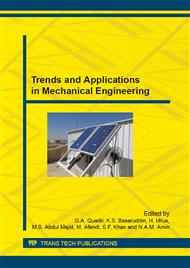p.248
p.257
p.262
p.269
p.275
p.281
p.287
p.292
p.300
Comparative Study of Rapid Upper Limb Assessment (RULA) and Rapid Entire Body Assessment (REBA) between Conventional and Machine Assisted Napier Grass Harvest Works
Abstract:
Most of Napier grass industry in Malaysia is labored in small and medium scale. Therefore, the harvesting works are done manually by man power using conventional equipment such as sickle and machete. However, there are some efforts made to design the low cost equipment in assisting this Napier grass harvesting works. The aim of this study is to compare the Rapid Upper Limb Assessment (RULA) and Rapid Entire Body Assessment (REBA) performance in order to evaluate the certain body parts condition during harvesting works by using conventional equipment and innovation machine assisted. Based on survey, conventional harvesting method might increase the risk of low back pain (LBP) due to repetitive stooping posture. Furthermore, the back biomechanical load and force impact were also not handling wisely. The objective of this study is to prove that the usage of machine during harvesting works might improve the body posture especially on stoop level condition. Based on results, the overall RULA and REBA score are excellently improved as well as trunk position which is depicts the stooped level condition. Hence, the innovation of harvest machine could contribute to the Napier grass industry especially on small and medium entrepreneur.
Info:
Periodical:
Pages:
275-280
Citation:
Online since:
August 2015
Price:
Сopyright:
© 2015 Trans Tech Publications Ltd. All Rights Reserved
Share:
Citation:


